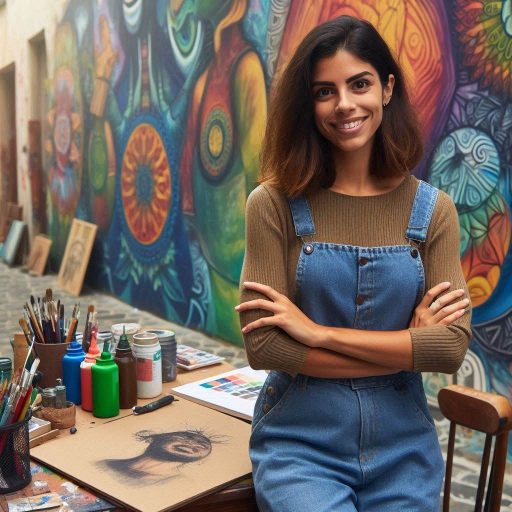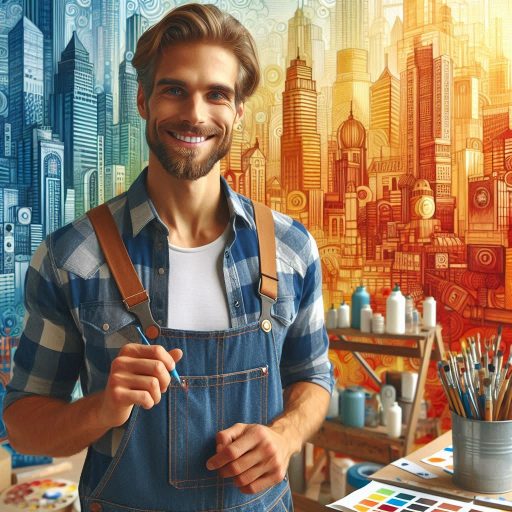Introduction
Mural art and design are powerful forms of visual expression.
They have the ability to transform ordinary spaces into vibrant and dynamic environments.
Mural art plays a crucial role in different communities by adding a sense of identity and culture to public spaces.
It serves as a medium for storytelling, social commentary, and community engagement.
The significance of mural art lies in its ability to engage with diverse audiences, convey powerful messages, and spark dialogue and creativity.
In essence, murals have the power to bring people together and create a sense of unity and pride within a community.
As we delve into exploring different styles of mural art and design, it is essential to recognize the impact that these artworks can have on the social, cultural, and political landscapes of our communities.
Each mural tells a story, conveys a message, and contributes to the rich tapestry of our shared human experience.
History of mural art
Origins of mural art
Mural art has been an integral part of human history for thousands of years.
The earliest known examples of mural art date back to ancient civilizations such as the Egyptians, Greeks, and Romans.
These early murals were often found in temples, tombs, and public buildings, serving as a form of visual communication and storytelling.
Evolution of mural art styles over the years
As time progressed, mural art evolved and diversified in style, technique, and purpose.
In the Middle Ages, murals were commonly seen in churches and cathedrals, featuring religious themes and narratives.
During the Renaissance period, artists like Michelangelo and Raphael used murals to showcase their skills and creativity, depicting scenes from mythology, history, and biblical stories.
In the 20th century, mural art underwent a significant transformation with the emergence of modern and contemporary styles.
Artists began using murals as a means of social commentary, political activism, and cultural expression.
Street art and graffiti murals became popular forms of urban art, challenging traditional notions of public art and engaging with a broader audience.
Read: How Technology is Influencing Modern Mural Art
Traditional mural art styles
Traditional mural art has been an integral part of various cultures around the world, showcasing unique characteristics and techniques that have been passed down through generations.
In this section, we will explore the characteristics of traditional mural art and provide examples from different cultures.
Transform Your Career Today
Unlock a personalized career strategy that drives real results. Get tailored advice and a roadmap designed just for you.
Start NowCharacteristics of traditional mural art
- Rich in cultural symbolism: Traditional mural art often incorporates symbols and motifs that hold significant cultural meanings.
- Bold and vivid colors: Traditional murals are known for their use of bright and bold colors that catch the viewer’s attention.
- Depiction of historical events: Many traditional murals depict historical events, myths, or legends that are important to the culture.
- Detail-oriented: Traditional mural artists pay close attention to detail, often creating intricate designs that require precision.
- Connection to nature: Traditional mural art often draws inspiration from nature, with motifs of animals, plants, and landscapes.
- Community involvement: Traditional mural art is often a communal effort, with artists collaborating with community members to create meaningful artwork.
Examples from different cultures around the world:
Mexican Muralism
One of the most well-known examples of traditional mural art is the Mexican Muralism movement, which emerged in the early 20th century.
Artists such as Diego Rivera, Jose Clemente Orozco, and David Alfaro Siqueiros created large-scale murals that depicted Mexican history, culture, and social issues.
These murals often featured bold colors, intricate details, and political messages that resonated with the Mexican people.
Indian Frescoes
In India, traditional mural art can be seen in the form of frescoes, which are painted on the walls of temples, palaces, and caves.
These murals often depict scenes from Hindu mythology, showcasing vibrant colors and intricate designs.
The Ajanta and Ellora caves in India are famous for their stunning frescoes that date back to ancient times.
Aboriginal Rock Art
The indigenous peoples of Australia, known as the Aboriginals, have a rich tradition of rock art that dates back thousands of years.
Aboriginal rock art often features intricate designs, symbols, and motifs that reflect the spiritual beliefs and cultural practices of the Aboriginal people.
These murals can be found in caves, rock shelters, and cliffs throughout Australia.
Korean Folk Murals
In Korea, traditional mural art can be seen in the form of folk murals that adorn the walls of homes, temples, and public buildings.
These murals often depict scenes from everyday life, nature, and folklore, with a focus on simplicity and harmony.
Korean folk murals are characterized by their subtle colors, delicate brushwork, and detailed compositions.
Traditional mural art styles showcase wide cultural variation and creativity.
Each style reflects unique characteristics and techniques from diverse cultures.
These murals embody the rich history of the artists.
Different cultures bring their own creativity to mural art.
By exploring traditional mural art from around the world, we gain a deeper appreciation for the diversity and beauty of this timeless art form.
Read: Top Mural Art Festivals and Events in the USA
Contemporary mural art styles
Contemporary mural art styles have evolved over the years, reflecting current trends and influences.
Showcase Your Business Today
Reach thousands of readers actively exploring professional services. Publish your business profile and grow your audience now.
Publish NowHere are some key aspects to consider:
Trends in modern mural art
- Abstract compositions: Contemporary mural artists often explore abstract forms and concepts in their work, creating visually dynamic pieces that challenge traditional ideas of representation.
- Interactive elements: Some modern murals incorporate interactive elements, such as QR codes or augmented reality technology, to engage viewers in new and innovative ways.
- Environmental themes: With growing awareness of environmental issues, many contemporary murals address themes related to sustainability, climate change, and biodiversity.
- Mixed media: Modern mural artists are increasingly experimenting with various materials and techniques, combining paint with elements like moss, metal, or digital projections.
- Geometric patterns: Geometric shapes and patterns are a common feature in contemporary mural art, offering a sense of order and structure amidst the chaos of urban landscapes.
Influence of street art on contemporary mural design
Street art has had a significant impact on the evolution of contemporary mural design, influencing artists to adopt new techniques and styles.
Here are some ways in which street art has influenced modern mural art:
- Emphasis on urban culture: Street art often reflects the gritty, vibrant energy of city life, incorporating elements of graffiti, tagging, and urban decay into mural designs.
- Social commentary: Many street artists use their work to address social and political issues, inspiring contemporary mural artists to engage with similar themes in their own work.
- Use of unconventional surfaces: Street artists are known for their ability to transform unconventional surfaces like alleys, abandoned buildings, and bridges into works of art, inspiring muralists to think outside the box.
- Collaborative projects: Street art often involves collaboration between artists, resulting in large-scale murals that showcase diverse styles and perspectives.
This spirit of collaboration has influenced contemporary mural artists to work together on ambitious projects. - Mural festivals: Street art festivals around the world have brought together artists from different backgrounds to create large-scale murals in public spaces, fostering a sense of community and creativity that has had a lasting impact on contemporary mural design.
Contemporary mural art evolves and innovates with fresh approaches.
Artists draw inspiration from street art and urban culture.
Global trends influence dynamic and engaging mural designs.
These artworks constantly push traditional mural boundaries.
Read: Mural Art Techniques: From Sketch to Wall

Different techniques used in mural painting
When it comes to mural art and design, there are a variety of techniques that artists use to create stunning pieces of work.
These techniques play a crucial role in determining the style, mood, and overall impact of a mural.
In this section, we will explore different techniques used in mural painting and how artists use them to achieve unique effects.
Overview of various painting techniques
- Brushwork: Artists use different types of brushes to create various textures and details in their murals.
- Spray painting: This technique involves using spray cans to achieve smooth gradients and intricate patterns.
- Sgraffito: Artists scratch away layers of paint to reveal underlying colors or create fine lines.
- Stenciling: Stencils are used to apply intricate designs or repeated patterns quickly and accurately.
- Mosaic: Muralists incorporate small pieces of colored glass, tiles, or other materials to create detailed mosaic murals.
- Aerosol art: This technique involves using aerosol paints to create vibrant, bold designs with a graffiti-style aesthetic.
How artists use techniques to create different effects
- Texture: By varying brushstrokes and layering paint, artists can create a sense of depth and texture in their murals.
- Color blending: Techniques like spray painting allow artists to blend colors seamlessly and create smooth transitions.
- Detailing: Fine brushwork or sgraffito techniques are used to add intricate details and elements to a mural.
- Scale: Artists can use stenciling or mosaic techniques to create large-scale murals with intricate patterns or designs.
- Mood: Different techniques can evoke different emotions or moods, from bold and energetic to subtle and contemplative.
- Visual impact: Techniques like aerosol art can create eye-catching murals that grab the viewer’s attention and leave a lasting impression.
Overall, the techniques used in mural painting play a significant role in shaping the visual impact and overall aesthetic of a mural.
Artists use various techniques to bring their vision to life.
They create detailed textures with precision and skill.
By blending colors seamlessly, they achieve smooth transitions in their work.
Adding intricate details, they enhance the depth and complexity.
These methods allow artists to produce large-scale masterpieces.
Read: Navigating Legalities: Permits and Contracts for Murals
Themes and Subjects in Mural Art
Choosing the right theme and subject matter for a mural is crucial as it sets the tone and message that the artwork conveys to the viewers.
In this section, we will explore popular themes in mural art and discuss the importance of selecting the right theme for the mural’s context.
Popular Themes in Mural Art
- Urban Life: Many murals depict scenes from urban settings, showcasing the vibrancy and diversity of city life.
- Nature and Wildlife: Mural art often celebrates the beauty of nature, featuring landscapes, animals, and plants.
- Social Justice: Murals can be powerful tools for advocating social change and raising awareness about important issues.
- Cultural Heritage: Artists draw inspiration from different cultures, traditions, and histories to create murals that reflect their roots.
- Fantasy and Surrealism: Some murals explore fantastical worlds and dream-like imagery that captivate the imagination.
These themes are just a few examples of the wide range of subjects that mural artists can explore in their work.
The choice of theme can significantly impact how the mural is perceived by the audience and its relevance to the surrounding environment.
Importance of Choosing the Right Theme for the Mural’s Context
- Relevance: The theme of a mural should resonate with the local community and reflect the cultural identity of the area.
- Impact: A well-chosen theme can evoke strong emotions and create a lasting impression on viewers.
- Engagement: Murals that address relevant and relatable themes are more likely to engage and connect with the audience.
- Communication: The theme of a mural serves as a form of visual communication, conveying messages and stories to the viewers.
- Harmony: A mural that aligns with its surroundings and context creates a sense of harmony and unity in the space.
When selecting a mural theme, artists must consider the location.
They need to understand the purpose of the artwork clearly.
Artists should also focus on the target audience.
Doing this helps them effectively convey the intended message.
The mural’s theme shapes the artwork’s impact and meaning.
It can depict local history, celebrate nature, or call for social change.
Each theme influences how viewers connect with the mural.
Collaborative mural projects
Benefits of collaborating with other artists on a mural
Collaborating with other artists on a mural project can bring a unique blend of creativity and ideas.
It allows artists to learn from each other, share techniques, and experiment with new styles and approaches.
Working together can also foster a sense of community and camaraderie among artists, creating a supportive environment.
Collaboration can help artists push their boundaries, challenge themselves, and grow as professionals.
By combining different perspectives and skills, collaborative mural projects can result in a more dynamic and impactful piece of art.
Artists can leverage each other’s strengths and compensate for weaknesses, leading to a stronger final product.
Examples of successful collaborative mural projects
- The Wynwood Walls in Miami, Florida: This outdoor museum features murals by renowned artists from around the world.
- The Mural Arts Program in Philadelphia, Pennsylvania: This initiative brings together local artists and community members to create vibrant murals.
- The Bushwick Collective in Brooklyn, New York: This street art project showcases collaborative murals by emerging and established artists.
- The Collaboration Collective in Los Angeles, California: This group of artists collaborates on large-scale murals that address social and cultural issues.
- The Nomad Clan in the UK: This duo of artists creates stunning murals that blend photorealism with surreal and dreamlike elements.
- The Berlin Wall Murals in Germany: These iconic murals were created by multiple artists as a symbol of unity and hope during turbulent times.
Each of these examples demonstrates the power of collaboration in mural art, showcasing the diverse talents and creative visions that emerge when artists work together.
Mural art in public spaces
Impact of mural art on urban environments
Mural art can transform dull, urban spaces into vibrant, cultural hubs.
It adds color, character, and a sense of identity to a community.
Mural art has the power to engage and inspire both residents and visitors.
It can spark conversations, bring people together, and foster a sense of belonging.
Showcase Your Business Today
Reach thousands of readers actively exploring professional services. Publish your business profile and grow your audience now.
Publish NowUrban environments with mural art often experience increased foot traffic and tourism.
Mural art contributes to the overall aesthetic appeal and cultural richness of a city.
In some cases, mural art has been used to revitalize neglected neighborhoods and buildings.
Challenges and controversies surrounding public mural projects
One of the main challenges is obtaining proper permissions and permits for mural installations.
Some communities may have strict regulations or guidelines for public art, which can hinder creativity.
Controversies can arise over the content or message of a mural, leading to debates and disagreements.
There may be issues with funding and financing mural projects, as they can be costly endeavors.
Maintenance and preservation of murals over time can also be a challenge for public spaces.
Critics may argue that mural art can perpetuate stereotypes or be a form of visual pollution.
Conclusion
We have explored several styles of mural art and design, including graffiti, street art, and traditional mural painting.
Each style brings a unique perspective and message to the community, showcasing the diversity and creativity of artists.
It is essential to preserve and support mural art in different communities as it contributes to the cultural richness and identity of a place.
Mural art has the power to transform public spaces, spark conversations, and inspire individuals to connect with their environment in a meaningful way.
By recognizing the value of mural art, we not only celebrate artistic expression but also promote community engagement and social dialogue.
Let us continue to appreciate and champion the vibrant world of mural art and design, ensuring its longevity and impact in our cities and neighborhoods.
[E-Books for Sale]
The Big Book of 500 High-Paying Jobs in America: Unlock Your Earning Potential
$19.99 • 500 High-Paying Jobs • 330 pages
Explore 500 high-paying jobs in America and learn how to boost your career, earn more, and achieve success!
See All 500 High-Paying Jobs of this E-Book
1001 Professions Without a Degree: High-Paying American Jobs You Can Start Now
$19.99 • 1001 Professions Without a Degree • 174 pages
Discover 1001 high-paying jobs without a degree! Unlock career tips, skills, and success strategies for just $19.99!




